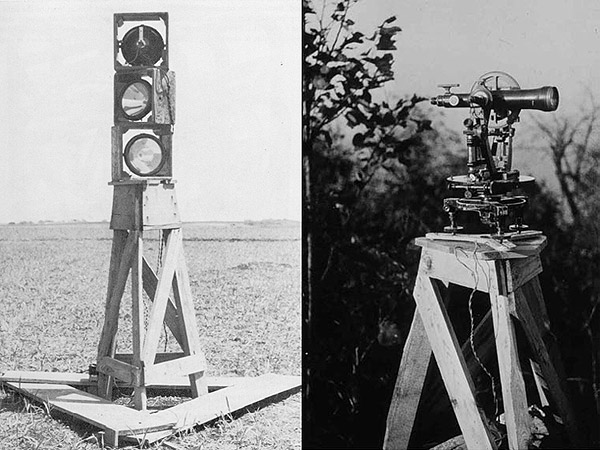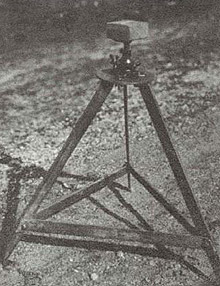Four-Foot Stand
Stands approximately four feet in height were used to support survey equipment such as later-model theodolites (instruments used to measure angles), signal lights (used as a target for the theodolites), electronic distance measurement instruments (EDMI), or mirrors (used to reflect the beam from the EDMI).

A four-foot stand with three older-style signal lights (left) and a four-foot stand with an theodolite (right).

An early version of the metal taping tripod.
Early survey instruments used low mounting stands because the instruments were very large and the goal was to have the telescope at the correct height for the observer. However, since 20th century theodolites such as the Parkhurst and Wild T-3 were not as tall, they required a stand about four-feet tall for normal ground observations. Thus, a four-foot stand eventually became a standard piece of survey equipment.
Each stand was built of lumber by the survey crew and typically reused many times. For stability, the inside of the stand was filled with rocks, if they were available. Wooden foot boards were installed in a triangular shape around the stand to isolate the weight and movement of the observer from the instrument. A few metal tripods were made for observations and for taping distances.
- Tower shown: Four-foot stand
- Approximate dates of use: Mid-1800s to 1984
- Height: 4 feet
- Materials of construction: Wood (lumber) and occasionally metal
- Unique features: Required for 20th century survey equipment.

 Timber Tower
Timber Tower Dimensional Lumber Tower
Dimensional Lumber Tower Pipe Tower
Pipe Tower Bilby Tower
Bilby Tower Peck Tower
Peck Tower Four-foot Stand
Four-foot Stand Truck Mounted Observing Tower
Truck Mounted Observing Tower G-Tower
G-Tower Trailer Mounted Tower
Trailer Mounted Tower Swedish Pole
Swedish Pole